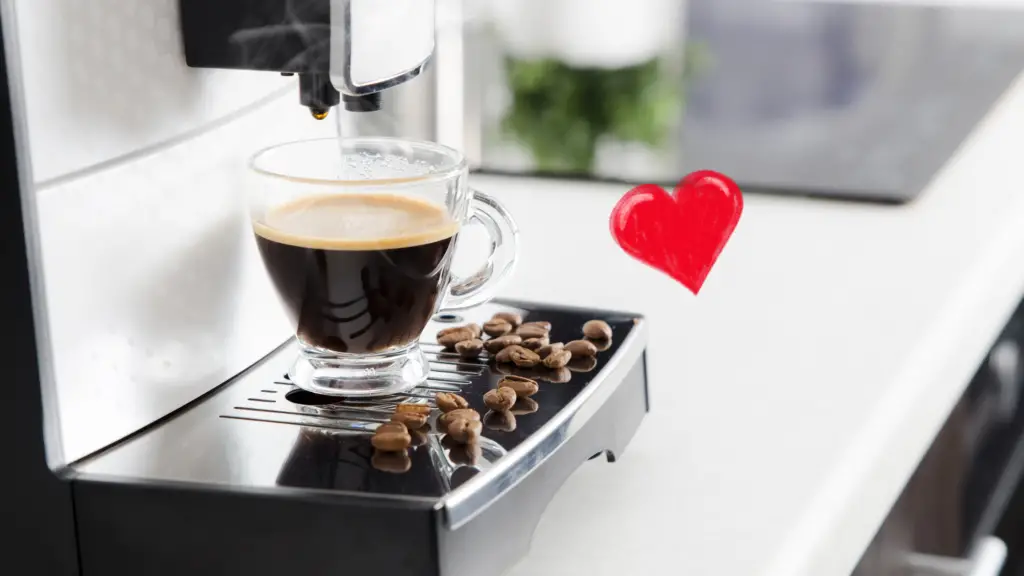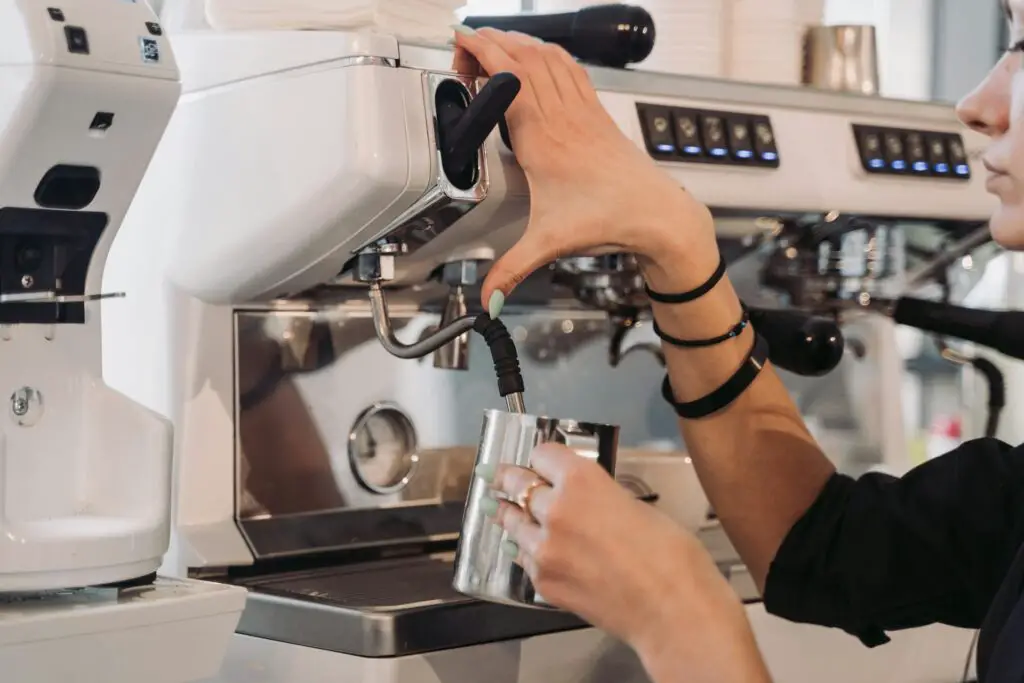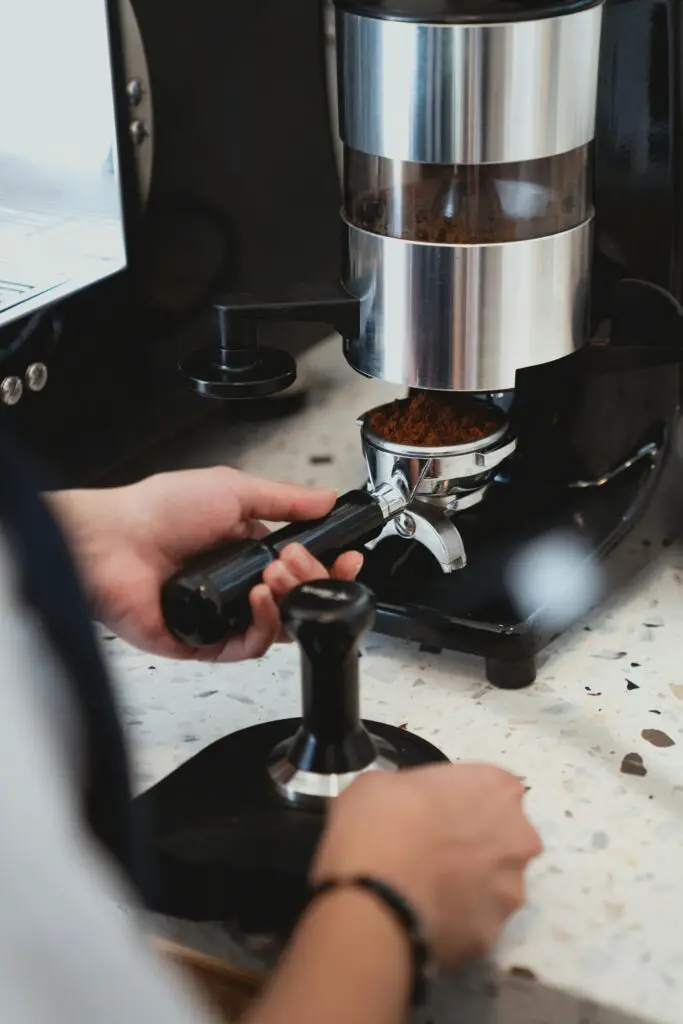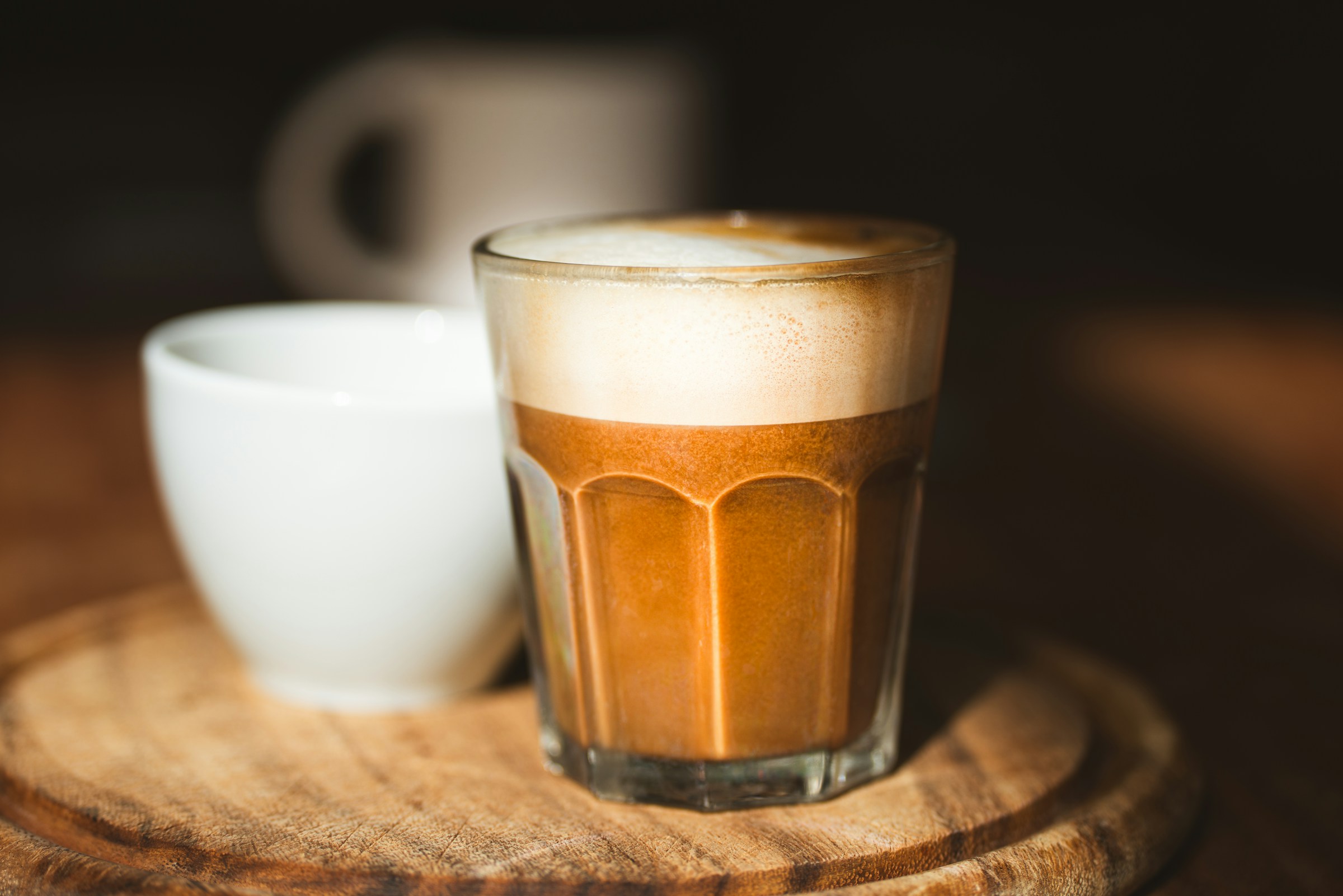A latte is a simple yet satisfying blend of espresso, steamed milk, and a light foam layer.
It’s one of the most popular coffee drinks around the world.
Why not skip the coffee shop line and make one at home?
It’s easier than you might think, and you can customize it as you like.
Plus, making your own latte saves money and lets you experiment with flavors and milk options.
Ready to give it a try?
Here’s the process of creating the perfect homemade latte.

How To Make The Perfect Latte At Home: At A Glance
- Step 1: Prepare the Espresso
- Step 2: Froth the Milk
- Step 3: Combine Espresso and Milk
- Step 4: Enjoy!
What is a Latte?

A latte is a coffee drink that combines espresso, steamed milk, and a small layer of milk foam.
The typical ratio for a latte is 1 part espresso to 2 or 3 parts steamed milk, depending on how strong or creamy you prefer it.
This balance creates a smooth, mild coffee flavor, making lattes a popular choice for those who enjoy a “milk-forward” experience.
Unlike a cappuccino, which has equal parts espresso, steamed milk, and foam (1:1:1), a latte has more milk and less foam, giving it a creamier texture.
A macchiato, on the other hand, is an espresso with just a dollop of foam or milk, offering a much stronger coffee taste.
Tools

- Espresso Machine: Recommended for the best results, as it provides the necessary pressure to extract rich espresso.
- Alternative Methods:
- AeroPress: Use 18g of ground coffee and brew to create a strong, concentrated coffee.
- Moka Pot: Brew 2 ounces of concentrated coffee.
- French Press: Brew a strong coffee concentrate using 2-3 times the usual amount of coffee grounds.
- Milk Frother Options:
- Automatic Milk Frother: Easiest and most consistent frothing.
- Handheld Milk Frother: Affordable and easy to use.
- Whisk: Manually froth milk by vigorously whisking.
- French Press: Froth by pumping the plunger up and down rapidly.
Ingredients

- Espresso: Use 1-2 shots (1-2 ounces) of espresso or strongly brewed coffee.
- Milk:
- Whole Milk: 6-8 ounces, for a rich and creamy froth.
- Oat Milk: 6-8 ounces, a great non-dairy alternative that froths well.
- Almond Milk: 6-8 ounces, lighter and suitable for those who prefer a nutty flavor.
- Optional Flavored Syrups:
- Vanilla Syrup: 1-2 teaspoons.
- Caramel Syrup: 1-2 teaspoons.
- Pumpkin Spice Syrup: 1-2 teaspoons, for a seasonal twist.
Step-by-Step Guide: How to Make a Latte

Step 1: Prepare the Espresso
- Using an Espresso Machine:
- Start by grinding 18 grams of coffee beans to a fine consistency.
- Place the ground coffee into the portafilter and tamp it down firmly.
- Insert the portafilter into the machine and brew 1-2 shots (about 1-2 ounces) of espresso.
- Alternative Methods:
- AeroPress: Use 18 grams of ground coffee and the inverted method to brew a strong, concentrated coffee. Press the coffee into a cup.
- Moka Pot: Fill the bottom chamber with water and the filter basket with ground coffee. Assemble and place on medium heat until the coffee starts to fill the upper chamber. Pour into a cup.
- French Press: Use 2-3 times the normal amount of coffee grounds. Brew for 4 minutes, then press the plunger down slowly. Pour the concentrated coffee into a cup.
Step 2: Froth the Milk
- Steaming with an Espresso Machine:
- Pour 6-8 ounces of milk (or your preferred alternative) into a frothing pitcher.
- Insert the steam wand just below the surface of the milk and start frothing.
- Gradually lower the pitcher to create a vortex, which helps achieve a silky microfoam.
- Heat the milk to 140°F – 155°F, being careful not to exceed this temperature to avoid scalding.
- Using a Milk Frother:
- Heat the milk to 140°F – 155°F on the stove or in the microwave.
- Use the handheld frother to froth the milk until it doubles in volume and creates small, foamy bubbles.
- Using a Whisk:
- Heat the milk to the desired temperature.
- Vigorously whisk the milk until it becomes frothy, creating a light foam on top.
- Using a French Press:
- Heat the milk as above, pour it into the French Press, and rapidly pump the plunger up and down to create foam.
Step 3: Combine Espresso and Milk
- Pouring Technique:
- Start by pouring the freshly brewed espresso into a cup.
- Slowly pour the frothed milk into the espresso, holding the cup at a slight angle to mix the coffee and milk smoothly.
- Finish by adding the foam on top.
- Optional: Basic Latte Art:
- To create a simple heart or rosetta pattern, start pouring the milk from a higher distance to integrate it with the espresso.
- As the cup fills, lower the pitcher and move it side to side to form the design.
- Practice makes perfect, so don’t be discouraged if your first attempts aren’t flawless.
Customizing Your Latte

Flavored Lattes
Customizing your latte with flavored syrups is a simple way to add a personal touch.
To create a vanilla latte, add 1-2 teaspoons of vanilla syrup to your cup before pouring in the espresso.
For a caramel latte, use caramel syrup in the same quantity.
If you’re in the mood for something seasonal, pumpkin spice syrup is a popular choice—just mix it in with your espresso before adding the steamed milk.
These syrups not only add sweetness but also infuse your latte with rich, layered flavors.
Feel free to experiment with the amount until you find the perfect balance for your taste.
Iced Lattes
Making an iced latte at home is easy and refreshing, especially on warmer days.
Start by filling a glass with ice cubes.
Pour cold milk over the ice—about 6-8 ounces, depending on how creamy you like it.
Next, brew 1-2 shots of espresso and pour it directly over the cold milk.
If you prefer a flavored iced latte, you can add 1-2 teaspoons of syrup before or after the espresso.
Stir gently, and your iced latte is ready to enjoy.
The cold milk and ice help mellow the espresso, creating a smooth and chilled coffee experience.
Vegan and Dairy-Free Options
For those who prefer a vegan or dairy-free latte, there are several great milk alternatives to choose from.
Oat milk is one of the best options because it froths well and has a creamy consistency similar to whole milk.
Almond milk is another popular choice, offering a lighter texture with a subtle nutty flavor.
When using alternative milks, it’s important to adjust your frothing technique.
Non-dairy milks typically require a slightly longer frothing time to achieve the desired texture.
Additionally, some plant-based milks may not froth as well as dairy milk, so you might need to experiment with different brands to find the one that works best for you.
Troubleshooting Common Issues

Milk Frothing Problems
One of the most common challenges when making a latte at home is getting the milk to froth properly.
If your milk isn’t frothing as expected, there are a few things to check.
First, ensure that the milk is at the right temperature.
Milk froths best between 140°F and 155°F.
If it’s too cold, it won’t foam well; if it’s too hot, the milk proteins break down, preventing proper frothing.
Another issue could be the type of milk you’re using.
Whole milk typically froths better due to its fat content, while non-dairy milks like almond or soy might require longer frothing time and may not produce as much foam.
If you’re using a manual method like a whisk or French press, make sure you’re frothing vigorously and consistently.
For those using a frothing wand, keep it just below the surface of the milk to introduce air, then lower it slightly to create a smooth microform.
If large bubbles form, gently tap the container on a flat surface to break them down.
Espresso Extraction Issues
Another common problem is the espresso itself, which might turn out too weak or overly bitter.
If your espresso is too weak, it could be due to under-extraction.
This often happens when the coffee grind is too coarse, the water temperature is too low, or the brewing time is too short.
To fix this, try using a finer grind, increasing the water temperature, or allowing the espresso to brew a bit longer.
On the other hand, if your espresso is overly bitter, it might be over-extracted, which can occur if the grind is too fine, the water temperature is too high, or the brewing time is too long.
To correct this, adjust to a slightly coarser grind, lower the water temperature, or reduce the brewing time.
Consistency is key, so experiment with these variables until you find the perfect balance that suits your taste.
Additional Tips for the Perfect Latte

Importance of Using Freshly Ground Coffee
One of the key elements of a great latte is the quality of the espresso, and nothing improves espresso more than freshly ground coffee beans.
Pre-ground coffee quickly loses its flavor and aroma due to oxidation, so grinding your beans just before brewing ensures the richest and most robust taste.
Invest in a good burr grinder to achieve a consistent grind size, which directly impacts the extraction and overall flavor of your espresso.
Freshly ground coffee beans elevate your latte, delivering the bold coffee flavor that pairs perfectly with the steamed milk.
Preheating Your Cup for a Better Experience
Preheating your cup is a simple but effective step to enhance your latte experience.
When you pour hot espresso and steamed milk into a cold cup, the temperature of your drink drops quickly, making it less enjoyable.
By preheating the cup with hot water and letting it sit for a minute, you ensure your latte stays warmer for longer.
This small detail helps maintain the smooth, comforting warmth that makes lattes so enjoyable.
Experimenting with Different Milk Ratios and Frothing Techniques
Creating the perfect latte also means experimenting with milk ratios to suit your taste.
While the standard ratio is 1 part espresso to 2 or 3 parts milk, you can adjust the milk amount for a stronger coffee flavor or a creamier drink.
If you prefer a more intense coffee taste, reduce the milk slightly.
If you like your latte extra smooth, increase the milk ratio.
Additionally, trying different frothing techniques can help you achieve the texture you prefer.
Some people enjoy a silky microfoam, while others might like a bit more froth on top.
Play around with different methods, whether using a steam wand, handheld frother, or even a whisk, until you find what works best for your perfect latte.
Conclusion
Making lattes at home is not only cost-effective but also allows you to customize each cup to your liking.
Whether you prefer a classic latte or want to experiment with different flavors and milk options, the process is simple and enjoyable.
Plus, with a bit of practice, you can perfect your technique and create café-quality drinks in the comfort of your kitchen.
So, grab your tools and ingredients, and start exploring the endless possibilities.
Don’t forget to share your creations and experiences with others—every cup is a chance to discover something new!
FAQs
Can I make a latte without an espresso machine?
Yes, you can make a latte without an espresso machine by using alternative methods to brew strong coffee.
A Moka Pot is a great option; it brews coffee that is close to espresso in strength.
Another method is using an AeroPress with a fine grind and a short brewing time to create a concentrated coffee.
You can also use a French Press by increasing the coffee-to-water ratio to make a stronger brew.
While these methods won’t produce authentic espresso, they can still give you a rich base for a homemade latte.
How do I make latte art at home?
Making latte art at home requires practice, but it’s a fun skill to learn.
Start with steamed milk that has a smooth, velvety microform.
To create a basic design, such as a heart, pour the steamed milk slowly into the center of the espresso, then move the pitcher from side to side as you finish pouring.
For a rosetta pattern, start the same way, but wiggle the pitcher as you pour and finish with a quick flick of the wrist to create the design’s stem.
It’s important to pour the milk at the right height—start high and gradually lower the pitcher as you create the design.
Patience and practice are key, so don’t worry if it takes a few tries to get it right.


